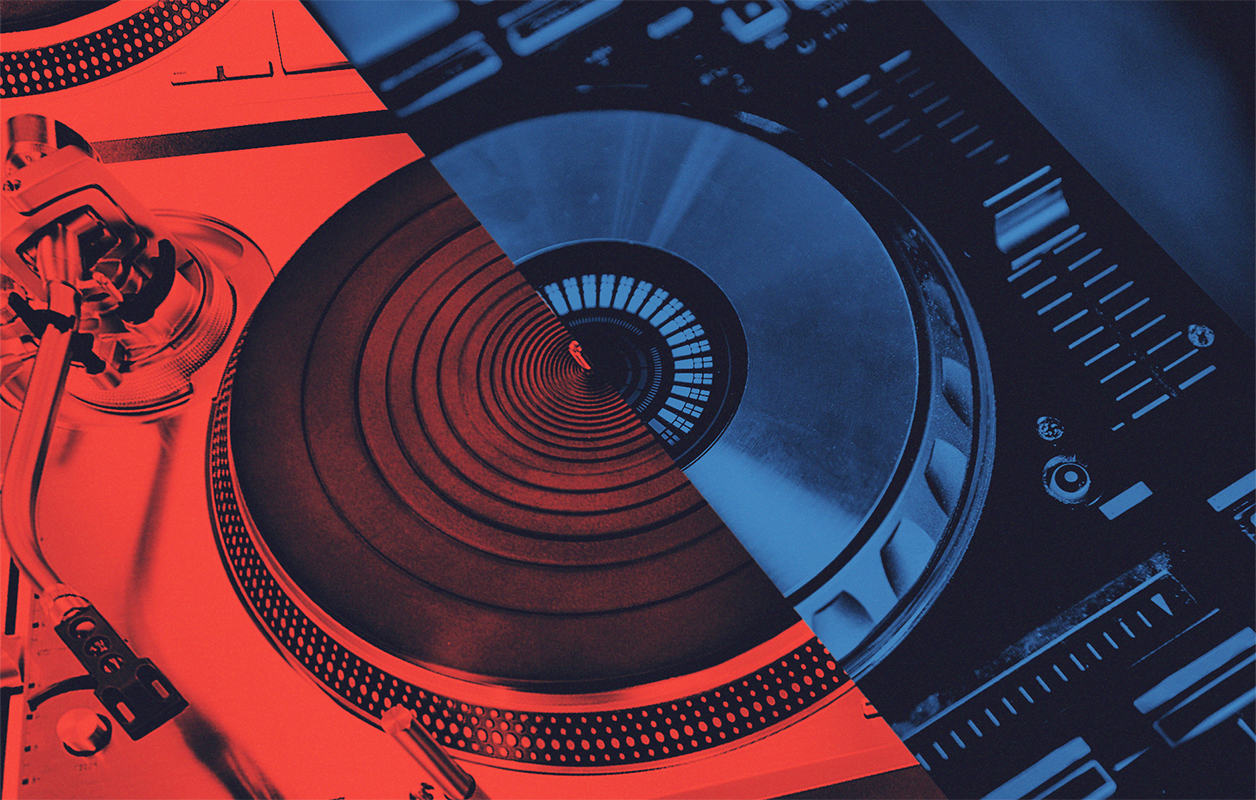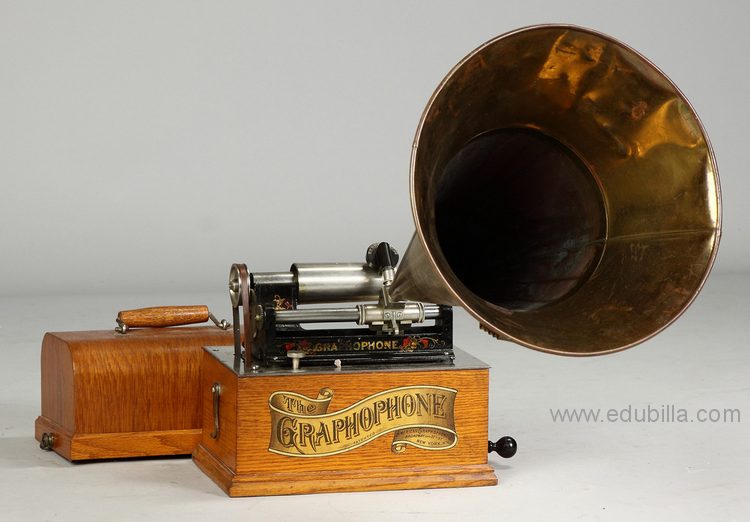
It took decades of innovation and trial-and-error until the turntable became a standard part of both households and club scenes. Music was once considered an activity for group outings and theater shows and not a leisurely pursuit. The turntable became a seminal part of life from the ‘60s to the ‘80s and returned again over the last decade. In fact, according to the RIAA, vinyl outsold CDs last year for the first time since 1986.
The History
In 1860, the first sound ever recorded happened and sounded a lot like a high-pitched child’s doll with dying batteries. It is inventor Édouard-Léon Scott de Martinville singing “Au Clair de la Lune,” a French children’s folk song, using his invention the phonautograph. The phonautograph had a funnel horn and would transcribe audio using burning oil from a lamp and soot onto paper, cranking the device with a fork to record that would also change the speed, hence the wobbly sounding recording.
Although the scripts were not transferred to audio until 2000, it is still considered the first recording device and set the path for the turntable to exist today that predates Edison’s invention of the phonograph.
Below is a photo of Édouard-Léon Scott de Martinville’s phonautograph, courtesy of Teylers Museum:

First Needle on a Groove
It wasn’t until 1887 when Thomas Edison, inspired by Scott de Martinville, invented the phonograph, which used foil instead of paper and replayed sounds. It used a vibrating diaphragm attached to a needle and made indents into the foil as someone maneuvers the device using its rotating wheels.
Edison, however, had not perfected the phonograph, unlike his previous inventions. Edison’s rival Alexander Graham Bell and Volta Laboratories had ideas for improvement since the tin foil method was difficult to use. Bell invented his own version of the phonograph that he called the graphophone, using wax instead of foil and a disc instead of a cylinder.
Shortly after, German inventor Emile Berliner would create the flat graphophone disc, using the name gramophone for the device. This was the beginning of the evolution of vinyl and the first use of a needle on a groove.
Below is a photo by Ed Ubilla of Alexander Graham Bell’s graphophone:

The 1920s came with the emergence of the radio, improving the sound of recorded audio. But it wasn’t until during WWII that records were in high demand. The first full-length 33 1/3 vinyl record, or LP, was invented in 1931. At 15-minutes per side, and introduced by RCA-Victor.
During the Great Depression, sales for record players were low. It took until the late 1940s for vinyl to gain notoriety, with the release of vinyl made with microgroove plastic LP invented by Peter Carl Goldmark. In 1948, Columbia would release Mendelssohn’s Concerto in E Minor by Nathan Milstein with the New York Philharmonic and a 131-song box-set including classical music and Frank Sinatra’s Songs by Frank Sinatra.
The Record Player
Now known as the record player, it became mainstream in the 1950s and saw high sales of 45 singles with teenagers. Elvis Presley cut a single in 1953, and by 1956 was signed to RCA-Victor, releasing his debut record and single “Hound Dog,” a Big Mama Thornton cover that would top the Billboard charts for weeks.
The introduction of household televisions also helped to create pop and rock stars that would soon sell albums, with shows such as American Bandstand introducing music to national television. Electronic company Philco developed the transistor phonographs that played 45s and were portable with built-in speakers. Dansette record players were popular in households until stereo record players were introduced in the late 1960s that provided high-fidelity listening of full records.
By the 1970s, stereo record players were a household item and the main method of music-listening that became a hobby for some. Record collecting started to become popular, as well as perfecting the sound for listening, using preamps and external speakers to enhance their experience.
Radio stations were keen on using the first direct-drive turntables. Technics SP-10 was introduced in 1969, followed by SL-1100 in 1971 and the SL-1200 in 1976, which changed the landscape for how music could be made. Disco was emerging in downtown Manhattan venues, and the club scene was growing.
Turntables & DJ Culture
DJs were seen as influential figures of music at the time, whether radio disc jockeys or providing the latest dance hits in nightclubs. DJs such as Kool Herc, Grand Wizard Theodore, and Grandmaster Flash used Technic turntables to practice their scratching and break methods. Technics’ rival was Thorens, a turntable used at Studio 54, and by DJs like Larry Levan, Francis Grasso, and Mancuso using the Thorens T125. Other turntables such as the Yamaha YP-701, the Dual 701, and Linn LP12 had been introduced but weren’t known to be used in the club scene.
Technics allowed DJs to control the speed and motion of a record easily, developing techniques such as the Quick Mix Theory that is heard on Grandmaster Flash’s single “The Adventures of Grandmaster Flash on the Wheels of Steel.” The 1981 release of The Message by Grandmaster Flash & The Furious Five was one of the first mainstream hip-hop records to use turntablism.
Dual’s CS505 was released in 1983 and was also an affordable turntable for listeners. In 1985, DMC DJ World Championships were hosted and allowed turntablists all over the world to battle against each other.
The CDJ Takeover
The record player’s heyday was dwindling by the ‘90s, but the rave scene, particularly the acid house scene, was growing in both England and the U.S. Novel turntable designs were developing, including 1997’s Pink Triangle Tarantella, which had a triangular platter, was popular in England. In 1997, Final Scratch was put on the market, and Pioneer released the CDJ-1000 in 2001, both allowing digital and compact disc music to be controlled like vinyl. The program Serato Scratch would be available in 2004 and would mix both CD and digital files to be combined with vinyl DJing. The turntables’ impact could be seen with mainstream video games such as DJ Hero, which emulated a disc jockey experience.
However, CDs would take over the market until the late 2010s, when vinyl became popular again. A surge in record sales meant a surge in analog players, and the development of technology meant that turntables could do much more than play vinyl. Record players could now connect to computers and phones, with USB ports and BlueTooth connection enhancing one’s listening experience as well as a new version of the Technics SL-1200 was released in 2016.
The Turntable Today
Turntable DJing still exists today, even amid the introduction of digital controllers connected to computer software instead of vinyl. Numark’s PartyMix, DJ2Go, and Mixtrack products include built-in light shows, effects paddles, and 4-channel controls at low-budget prices, while Pioneer DJ’s DDJ series is a best-selling controller. A recent DJ controller product called Phase has been deemed the “future of Djing” by DJ Jazzy Jeff and is the first wireless controller that doesn’t use a needle.
While these innovations may rival the original turntable, vinyl sales are thriving, and the evolution of the analog turntable continues.

